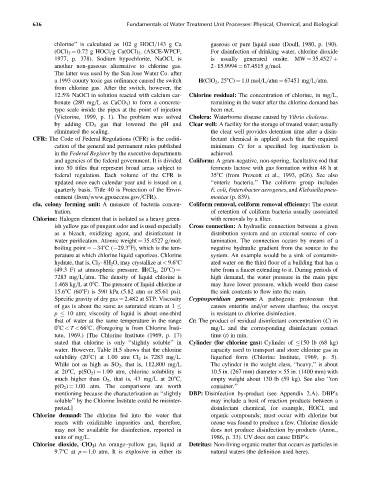Page 681 - Fundamentals of Water Treatment Unit Processes : Physical, Chemical, and Biological
P. 681
636 Fundamentals of Water Treatment Unit Processes: Physical, Chemical, and Biological
chlorine’’ is calculated as 102 g HOCl=143 g Ca gaseous or pure liquid state (Doull, 1980, p. 190).
(OCl) 2 ¼ 0.72 g HOCl=g Ca(OCl) 2 . (ASCE-WPCF, For disinfection of drinking water, chlorine dioxide
1977, p. 378). Sodium hypochlorite, NaOCl, is is usually generated onsite. MW ¼ 35.4527 þ
another non-gaseous alternative to chlorine gas. 2 15.9994 ¼ 67.4515 g=mol.
The latter was used by the San Jose Water Co. after
a 1993 county toxic gas ordinance caused the switch H(ClO 2 ,258C) ¼ 1.0 mol=L=atm ¼ 67451 mg=L=atm.
from chlorine gas. After the switch, however, the
12.5% NaOCl in solution reacted with calcium car- Chlorine residual: The concentration of chlorine, in mg=L,
bonate (280 mg=L as CaCO 3 ) to form a concrete- remaining in the water after the chlorine demand has
type scale inside the pipes at the point of injection been met.
(Victorine, 1999, p. 1). The problem was solved Cholera: Waterborne disease caused by Vibrio cholerae.
by adding CO 2 gas that lowered the pH and Clear well: A facility for the storage of treated water; usually
eliminated the scaling. the clear well provides detention time after a disin-
CFR: The Code of Federal Regulations (CFR) is the codifi- fectant chemical is applied such that the required
cation of the general and permanent rules published minimum Ct for a specified log inactivation is
in the Federal Register by the executive departments achieved.
and agencies of the federal government. It is divided Coliform: A gram-negative, non-sporing, facultative rod that
into 50 titles that represent broad areas subject to ferments lactose with gas formation within 48 h at
federal regulation. Each volume of the CFR is 358C (from Prescott et al., 1993, pG6). See also
updated once each calendar year and is issued on a ‘‘enteric bacteria.’’ The coliform group includes
quarterly basis. Title 40 is Protection of the Envir- E. coli, Enterobacter aerogenes, and Klebsiella pneu-
onment (from=www.gpoaccess.gov=CFR). moniae (p. 839).
cfu, colony forming unit: A measure of bacteria concen- Coliform removal, coliform removal efficiency: The extent
tration. of retention of coliform bacteria usually associated
Chlorine: Halogen element that is isolated as a heavy green- with removals by a filter.
ish yellow gas of pungent odor and is used especially Cross connection: A hydraulic connection between a given
as a bleach, oxidizing agent, and disinfectant in distribution system and an external source of con-
water purification. Atomic weight ¼ 35.4527 g=mol; tamination. The connection occurs by means of a
boiling point ¼ 348C( 29.38F), which is the tem- negative hydraulic gradient from the source to the
perature at which chlorine liquid vaporizes. Chlorine system. An example would be a sink of contamin-
hydrate, that is, Cl 2 8H 2 O, may crystallize at < 9.68C ated water on the third floor of a building that has a
tube from a faucet extending to it. During periods of
(49.3 F) at atmospheric pressure. H(Cl 2 ,208C) ¼
7283 mg=L=atm. The density of liquid chlorine is high demand, the water pressure in the main pipe
1.468 kg=Lat08C. The pressure of liquid chlorine at may have lower pressure, which would then cause
15.68C (608F) is 590 kPa (5.82 atm or 85.61 psi). the sink contents to flow into the main.
Specific gravity of dry gas ¼ 2.482 at STP. Viscosity Cryptosporidium parvum: A pathogenic protozoan that
causes enteritis and=or severe diarrhea; the oocyst
of gas is about the same as saturated steam at 1
p 10 atm; viscosity of liquid is about one-third is resistant to chlorine disinfection.
that of water at the same temperature in the range Ct: The product of residual disinfectant concentration (C)in
08C < T < 668C. (Foregoing is from Chlorine Insti- mg=L and the corresponding disinfectant contact
tute, 1969.) [The Chlorine Institute (1969, p. 17) time (t) in min.
stated that chlorine is only ‘‘slightly soluble’’ in Cylinder (for chlorine gas): Cylinder of 150 lb (68 kg)
water. However, Table H.5 shows that the chlorine capacity used to transport and store chlorine gas in
solubility (208C) at 1.00 atm Cl 2 is 7283 mg=L. liquefied form (Chlorine Institute, 1969, p. 5).
While not as high as SO 2 , that is, 112,800 mg=L The cylinder in the weight class, ‘‘heavy,’’ is about
at 208C, p(SO 2 ) ¼ 1.00 atm, chlorine solubility is 10.5 in. (267 mm) diameter 55 in. (1400 mm) with
much higher than O 2 , that is, 43 mg=Lat 208C, empty weight about 130 lb (59 kg). See also ‘‘ton
p(O 2 ) ¼ 1.00 atm. The comparisons are worth container.’’
mentioning because the characterization as ‘‘slightly DBP: Disinfection by-product (see Appendix 2.A). DBP’s
soluble’’ by the Chlorine Institute could be misinter- may include a host of reaction products between a
preted.] disinfectant chemical, for example, HOCl, and
Chlorine demand: The chlorine fed into the water that organic compounds; most occur with chlorine but
reacts with oxidizable impurities and, therefore, ozone was found to produce a few. Chlorine dioxide
may not be available for disinfection, reported in does not produce disinfection by-products (Anon.,
units of mg=L. 1986, p. 33). UV does not cause DBP’s.
Chlorine dioxide, ClO 2 : An orange–yellow gas, liquid at Detritus: Non-living organic matter that occurs as particles in
9.78Cat p ¼ 1.0 atm. It is explosive in either its natural waters (the definition used here).

